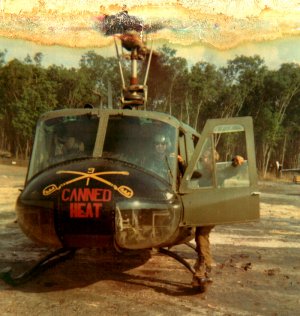Huey Helicopter Serial Numbers
• • • • • • • • • Vietnam UH-1H “Huey” Helicopter From 1965 to 1973, the Bell UH-1, officially named “Iroquois” was the most common utility helicopter used in Vietnam. The “Huey” nickname stuck thanks to her early “HU-1” designation (it was later redesignated to UH-1 with the normalization of 1962).

This particular helicopter is a “Slick”, used for troop carrying. It is not fitted with external weapons to save weight and is only armed with the M60s used by the door gunners. These aircraft operated in the hostile environment of Vietnam for almost a decade. This Huey served in the 25th Infantry Division in Vietnam, performing troop insertions and extractions, medical evacuations, helicopter crew recoveries, smoke, sniffer psyops, and firefly missions. Based at Cu Chi, it survived multiple small arms attacks and one RPG strike. It was returned to service in 2011 to operate as a “Thank You” to Vietnam War Veterans and has completed over 180 missions since then. Many Vietnam Veterans describe the UH-1 “Huey” helicopter as the “sound of our war”.
Huey helicopter commemorating Vietnam War coming to Phoenix area. Helicopter sculpture. And he also began looking into the Huey’s history. From the serial number. Vietnam Era Helicopter Displays. No information regarding Serial Numbers. Bob Pederson to UH-1 Huey Helicopter.
Vietnam Helicopter Pilots Association records show that 7,013 Hueys survived in the Vietnam War, totaling 7,531,955 flight hours. Over 90,000 patients were airlifted (over half of them Americans). The average time between field wound to hospitalization was less than one hour. During the Korean and World War II wars this time was measured primarily in days, not hours. The utilization of helicopters dramatically increased warfare survival rates. The “Big Picture” Over 10% of all combat and combat support deaths in Vietnam occurred in helicopter operations, a combined total of 6,175 (2,202 pilots, 2,704 aircrew and 1,269 passengers). About 86% of these causalities were U.S.
In addition to the human cost, the helicopter “casualties” of the war were staggering. A total of 11,800 helicopters of all types served in Vietnam.
Approximately 5,000 helicopters were destroyed there, of which all but 500 were U. Ultima Patch Fifa 13. S. Armament Primary Armament: Typical armament included two M-60D machine guns on fixed door mounts manned by the Crew Chief on the left and a Door Gunner on the right. The M-60D is a 7.62mm NATO caliber weapon with a cyclic rate of fire of 600 to 700 rounds per minute.
The large cans below the M-60’s held roughly 2,000 rounds of linked 7.62mm ammunition and were a typical field modification replacing the authorized can which held 500 rounds. Secondary Armament: Each Crew Chief and Door Gunner also carried a secondary weapon, usually an M-16 rifle but sometimes more exotic types.
Because pilots were not issued M-16’s, they often carried other unauthorized weapons slung over their armored seats for personal protection. Crew Chiefs and Door Gunners always carried colored smoke grenades, often as you see them here on the seat posts. Terraria Android Download Free 1.1.8 on this page. These were used to mark targets for the Gunships when receiving hostile fire or to mark landing zones (LZ’s). Body Armor All aircrew were issued body armor, jokingly referred to as “chicken plates”.
If a Crew Chief or Door Gunner chose not to wear it, the chicken plate was often stowed under his seat for protection from enemy weapons fire from below. Crews In Vietnam the UH-1 had a crew of four: Aircraft Commander (A/C), Co-pilot or “Peter Pilot,” Crew Chief (C/E) and Door Gunner. The Aircraft Commander, as his name implied, was in command of the aircraft at all times while on a mission. The Co-pilot assisted the Aircraft Commander in the air and flew the aircraft as needed.
Most pilots began their tour in Vietnam as a Co-pilot and advanced to Aircraft Commander as they gained experience. In many units, the Aircraft Commander and Crew Chief were assigned a specific aircraft and Co-pilots generally rotated among unit aircraft. In addition, the Crew Chief was the only crew member personally responsible for maintaining his aircraft. The Crew Chief and his Door Gunner would work many hours before and after each mission maintaining their helicopter. Besides aiding the Crew Chief on the ground, the Door Gunner also assisted in loading and unloading the aircraft and manned the right door gun while flying. As with the Co-pilots, they usually rotated among unit aircraft.
Missions and Loads The Huey slick’s primary mission was carrying infantry into combat, commonly called “combat assaults” which involved a “package” of up to 8 or 10 slicks carrying the infantry, supported by two or three gunships and monitored by a Command and Control slick (Charlie/ Charlie) orbiting overhead. During combat assaults, depending on density altitude and the strength of the particular aircraft, the UH-1 could carry 6 to 8 American infantrymen or 10 or more Vietnamese (due to their smaller size and weight). Other missions included supplying replacement personnel, food, water, ammunition and necessities to infantry units in the field or at forward bases.